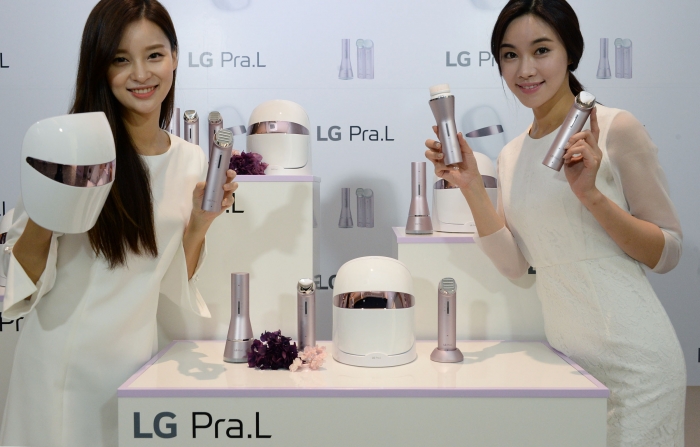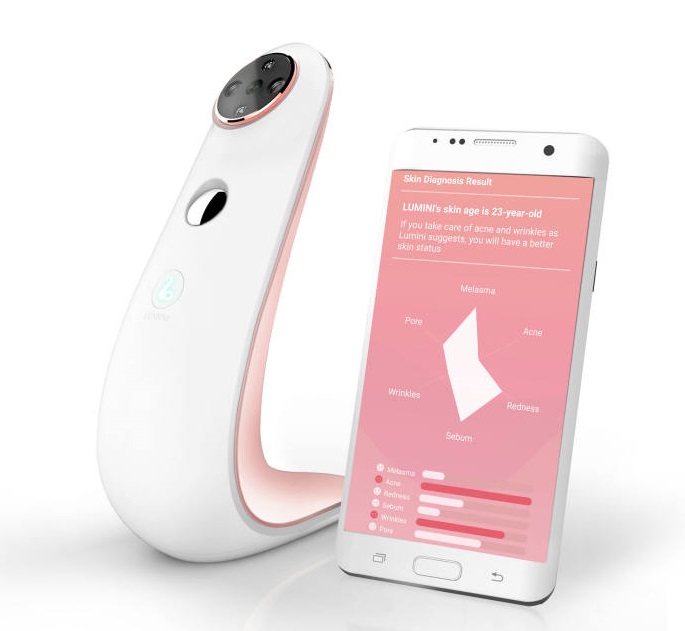
Models display the “LG Pra.L” beauty appliance lineup released by LG Electronics Co. during a launch event held in Seoul on Sept. 25, 2017. (image: LG Electronics)
SEOUL, Nov. 10 (Korea Bizwire) — Kim Na-yul, a 38-year-old PR manager in Seoul, regularly sees dermatologists to get “intensive care” to erase dark spots and shrink the pores on her nose and cheeks.
“After I turned 30, I started buying more expensive creams and essences. And in recent years, I decided to get help from the latest laser technology, though it costs quite a bit of money,” said Kim, who looks like she is in her late 20s or early 30s. “Good skin condition is what makes you look younger. So I think it’s worth the money.”
Recently, she found another way to reduce the wrinkles around her eyes without going to clinics.
She bought an “ultrasonic ion massager” from a home shopping channel for 199,000 won (US$180) after seeing TV show hosts hailing it as “the ultimate item” for those who have skin trouble.
“I bought it impulsively, thinking it would be a money saver if it really worked as advertised,” the unmarried Kim said. “Good things may take time. I am wondering how things will turn out.”
The chic office worker is one of many beauty-conscious consumers who are increasingly turning their eyes to the latest at-home skin care gadgets, which range from cleansing and massage devices to LED therapy and oxygen generators.
In 2013, L’Oréal Group, one of the world’s top cosmetics makers, launched an advanced skin care system for cleaning and firming for Korean women, who are known for their intensive skin care routines. Since then, global electronics makers, including Philips, Panasonic and Toshiba, and South Korea’s big two cosmetic firms — AmorePacific Co. and LG Household & Health Care Ltd. — have all launched various skin care gadgets.
Their introduction of innovative beauty products comes as the niche market is expected to grow even more, with tech-savvy consumers being more willing to use them on their skin.
According to P&S Market Research, the global beauty devices market is likely to grow from $27.8 billion in 2016 to $94.3 billion by 2023.
“Introduction of new beauty devices, increasing utilization of electronic beauty devices and rising inclination of consumers towards easy to use at home beauty devices are some of the major trends observed in the global beauty devices market,” the New York-based market researcher said in a report.
“Increasing prevalence of skin diseases, growing aging population, increasing hormonal disorders and high disposable income are some of the major factors driving the growth of the global beauty devices market,” it added.
Eyeing potential in the market, South Korea’s tech giants have started to showcase new beauty technology as they see more consumers seeking convenient ways to maintain themselves.
In September, LG Electronics Inc. launched its “LG Pra.L” beauty appliance lineup, showcasing four items — the Derma LED Mask, the Total Lift-up Care, the Galvanic Ion Booster and the Dual-Motion Cleanser. Their price tags range from $200 to $700.
Its LED mask and lift care use high-frequency LEDs and microcurrents to improve skin tightening. Its booster helps cosmetics penetrate deeper into the skin, and the cleanser is capable of washing skin 10 times better than conventional methods, the company said.
“The home beauty business was born with a vision of applying artificial intelligence and big data technologies to the market,” Seo Young-jae, a senior official from LG Electronics’ home appliance division, said in a launch event. “Data is a crucial part of the cosmetics industry.”

Lumini, a portable skin scanning device developed by the tech giant’s Creative Lab, an in-house initiative for innovative projects. (image: Samsung Electronics)
Samsung Electronics Co., the world’s largest smartphone manufactuer, has introduced two devices that analyze users’ skin and offer solutions for any issues they might have.
During a Consumer Electronics Show (CES) in Las Vegas in January, Samsung’s Creative Lab unveiled S-Skin, a home skincare and analysis solution, and Lumini, a portable device that checks your skin to identify and prevent skin problems.
Lumini and S-Skin can scan skin for issues such as dryness, blemishes, excess sebum, wrinkles and more. Both devices send users’ information to corresponding smartphone apps that will offer solutions, products, and even recommend dermatologists that they can chat with in the app.
“The gadgets will take a picture of the whole face and will analyze the skin condition immediately, and even track the history of wrinkles,” said Lee Sang-myung, a public relations officer at Lumini, which spun off from Samsung Electronics in May. “We plan to launch the product in the first quarter of 2018, first targeting cosmetic shops and skin care clinics.”
While some devices promise an “instant” or “dramatic” effect on the skin, dermatologists say careful application is needed to use products that utilize lasers or certain forms of light because they could damage skin if used improperly.
“Dermatologists have used blue lights to kill acne-causing bacteria for years,” No Do-gyun, a dermatologist in Seoul, said. “But even medical-grade red lights may not drastically improve wrinkles. They’re best for calming inflammation. Those with sensitive skin should use home beauty devices carefully, especially laser or light gadgets.”
(Yonhap)






